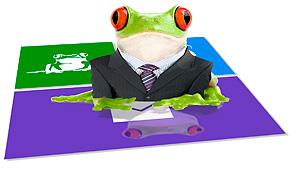DECEMBER 2012: Unless you’ve been trapped under a lily pad for the last month, you know that Windows 8 is here! But do you know what it means for your business?
By completely retooling the operating system — the first major innovation since 1995 (very exciting for us frogs) — Microsoft is attempting to change the way we do business. The new touch-friendly platform transitions businesses from an environment that’s dominated by PCs and laptops into one that’s dominated by mobile and touch-enabled devices. The overall concept is for all devices to work together seamlessly on a single operating system, whether we’re at our desks or on our smartphones or anything in between. Even Apple hasn’t accomplished that yet.
Here’s a quick overview of what makes Windows 8 different, plus Leapfrog’s top three recommendations for moving forward:
By now you’ve seen the new user interface “live tiles” on the Start screen — they are by far the most noticeable difference. If you look for the familiar Start button, Start menu or command line, you won’t find them! They’re gone, at least on the surface (pun intended … learn more about Microsoft Surface tablets here and in future FrogTalk issues). The tiles interface, formerly known as Metro, offers a dashboard-like functionality that presents real-time data within the tiles. Each tile is also connected to something, like an app, website, file, contact, playlist, weather or other options of your choice. The tiles are constantly updating and light up when they have new information for you.
While the interface is intuitive on mobile devices, it’s a different story when using a mouse. Your team will need to learn and use shortcuts until they’re working on desktops and laptops that have touch screens.
What’s underneath the Windows 8 live tile front page? Basically, Windows 7! Which largely explains our top three tips for preparing your business for Windows 8 (more advice here):
Tip # 1) Wait.
Windows 8 is not replacing Windows 7. And Microsoft has no plans to phase out Windows 7 in the foreseeable future. As we say every day at Leapfrog: Leading edge rocks! Bleeding edge, not so much. Your business relies on vetted antivirus and other software to run your business. It will take a year or two for Windows 8 to be completely ready for prime time for most businesses.
Tip # 2) But don’t wait if you’re struggling with Windows 7 on touch devices in the field.
Consider hopping on Surface with Windows 8 Pro, the commercial Windows 8 tablet, when it’s released (compare versions here). Then get the training so you can leap into greater productivity more quickly.
Tip # 3) Take intermediary steps.
Have your team get used to Windows 8 on Windows Phones or Surface tablets. Then, for desktops and laptops, run Windows 7 and Windows 8 at the same time, with Windows 8 as a virtual machine inside Windows 7 (or vice versa). Find more details here.
Check out Windows 8 from an enterprise point of view and see how Microsoft is helping developers build apps for the Windows Store (includes handy guidance for converting iPad apps to Windows 8 apps). For a general overview and some insight into Windows 8 appearance and heavy scrolling, check out the Windows 8 marketing site.
Want even more great advice from Leapfrog? Here’s our deeper dive into Windows 8, plus an important tip for Windows XP users.

